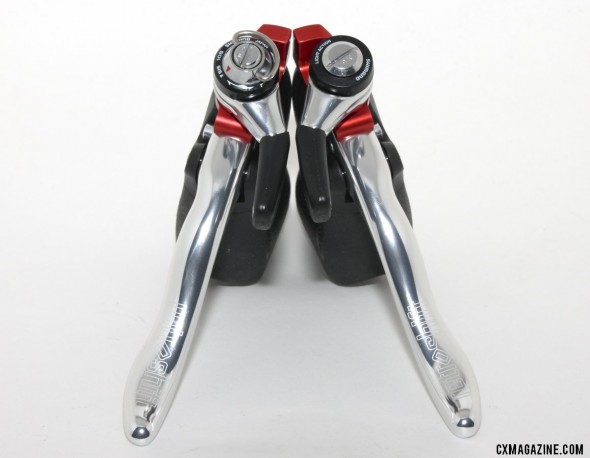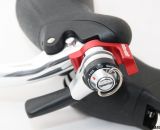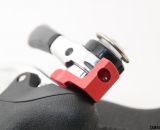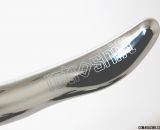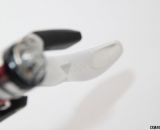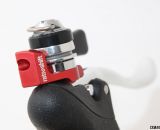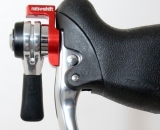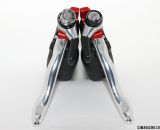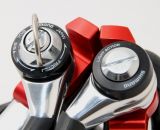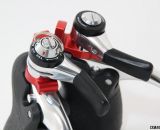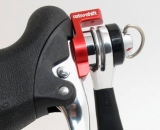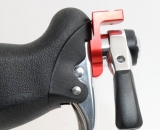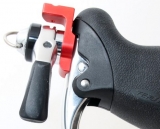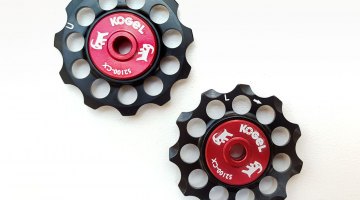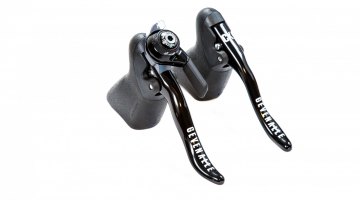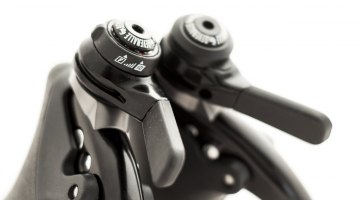As we enter the sloppy period of the cyclocross season, some of you may have suffered from gunked-up or broken shift levers and races hampered by unreliable drivetrains. If you’re on a budget and prefer reliability over conformity, Retroshift has an alternative shifter and brake lever combination worth considering. This review by Andrew Yee originally appeared as just one of many products reviewed in Issue 17 of Cyclocross Magazine, available instantly via uberflip or the Apple Newsstand. Update: The $189 Retroshift CX2 has been updated since our review and now comes with 9 or 10-speed Microshift shift levers standard, and the company offers a CXV for V-brakes and $139 CX1 for single ring systems)
Adam Clement, the man behind Retroshift, is a tinkerer. For nearly two years I’ve seen photos and prototypes of his shifting system. Being someone who, as a poor college student, bolted a thumb shifter to his drops when his Shimano STI brake/shift lever (“brifter”) broke, I admire Clement for thinking creatively to find an alternative to the three main brifters we have to choose from (Shimano STI, SRAM DoubleTap, and Campagnolo Ergopower).
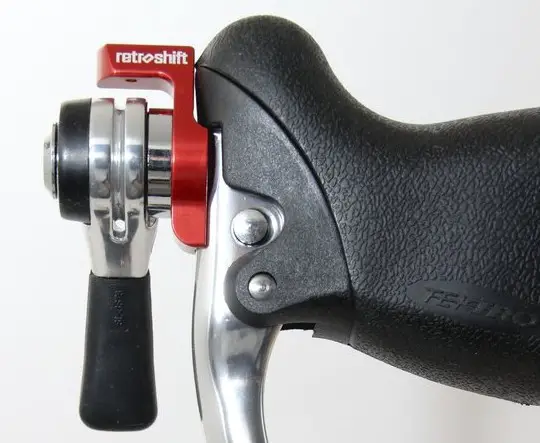
Retroshift: A simple shifter and brake lever combo for reliable performance in mud, and after crashes. © Cyclocross Magazine
Why bother with an alternative? If you’re already wondering this, you’re probably not Retroshift’s target market. But if you’ve ever broken or jammed a shift lever in a cyclocross race or on a long ride and had your day ruined, you might want to keep reading. By simply naming his company Retroshift, Clement already makes it easy for racers to self-select into one of two groups: those who will scoff at his contraption, or those who will be at least curious as to whether Retroshift might be worth trying. If the name doesn’t scare you off, chances are you might remember a day when shift levers were made up of just a few parts; didn’t rely on multiple springs, carbon and plastics; and would never been rendered useless by a race in deep mud or sand, or by a simple crash.
Even though one of my cyclocross bikes still has a bar-end front shifter on it, after pulling the $189 Retroshift CX2 out of the box, I was still skeptical as to whether the idea of bolting a Barcon or down-tube shifter to the front of a brake lever made sense, especially because such levers do not recenter themselves. And unlike with a Barcon or down-tube shifter, you can’t just change your hand position to execute the shift since your hands are already gripping the hoods. Would I be able to reach the lever in every gear? Could I shift in a sprint? Would it get in the way of braking? I installed the 10-speed CX2 levers on a vintage ’cross-able Trek road bike that split time between fat slicks and knobbies, and I promptly entered a NorCal mixed-terrain race.
As luck would have it, it was probably the wettest day of spring, and a mixture of road grit, dirt, sand and silt built up in layers on my bike as the hours went by. The Caveman (Erik Tonkin, pro and shop owner) saw my levers at an aid station and gushed at how well they worked for him last season. I thought it’d take me most of the ride to get used to the shifting, but I found I didn’t need more than 30 seconds to get used to the levers. I never missed a single shift and never felt that the levers got in the way during some deathly scary, “hold on for dear life” slimy descents. After one ride, I was convinced Clement was onto something for cyclocross, mixed-terrain and adventure applications.
Now that CXM tester Clifford Lee and I have spent several months on the levers, we have much more specific impressions about them. We absolutely love the right shifting and find that we can execute every rear shift easily from the hoods. Shifting from the drops is difficult, if not impossible, but it’s quite rare that I need to do so in cyclocross or in any other types of riding I do on my cyclocross bikes. Sure, during a tricky sprint in the drops for 22nd I might miss the chance to upshift, but such a situation is actually quite rare and is not the dealbreaker it’d be if I was a criterium specialist. The beauty of the system is that you can do multiple shifts, including the full range, with a single lever throw, and when something happens to mess with the indexing (mud, cable stretch, a bumped derailleur hanger or a wheel swap), the levers allow you to nudge the shift lever to complete a shift in a way that a ratcheting system won’t. And then there’s always the ability to shift on the fly to friction mode. I personally liked the CX2’s rear shifting so much that they’d absolutely be my levers of choice for a 1×10 setup if I was building the bike from scratch. At $139, including a rear shifter, the CX1 levers are an affordable way to cover your braking and shifting needs without being stuck with the extra weight of a front brifter, or the burden of needing to sell that front brifter and buy a single left brake lever.
The CX2’s left shifting took much more getting used to, partially because I paired it with a vintage Shimano 600 front derailleur that requires more cable pull than a modern front derailleur. The “default” installed lever position had me unable to throw the lever enough to even make it into the big ring. But the beauty of Retroshift is that anybody with a fl at-head screwdriver can quickly customize the levers. I simply rotated the shift lever on its mount outward by 90 degrees, and suddenly front shifts were much easier, plus the infinite trim options of the Barcon lever meant no chain rub in any gear combination. Still, because the lever had to travel quite a distance in one motion just to pull enough cable to execute a front shift, it never felt very quick or confidence-inspiring, despite the fact that my fingers are quite long. I felt like a bar-end shifter would be capable of a slightly faster shift (since you can use your whole hand), but of course would require taking your hand off the brakes. Clifford’s test unit originally came with down-tube shift levers, which worked fine, but he opted to swap them out for some Shimano Barcons he already owned, enjoying the change in ergonomics and appreciating the rubber covers of the Barcons over the all-metal downtube levers. However, in the end he preferred the spring-assisted front shifting of the left down-tube lever.
The neat thing is that the possibilities with Retroshift are quite endless. Find a 6-, 7-, 8-, 9-, or 10-speed index down-tube or Barcon shift lever that also runs in friction mode, pair that lever with Retroshift, and you can grab almost any old rear wheel and go for a ride in friction mode (provided that the rear hub spacing works with your frame and your chain doesn’t fall through the gaps in that 5-speed freewheel).
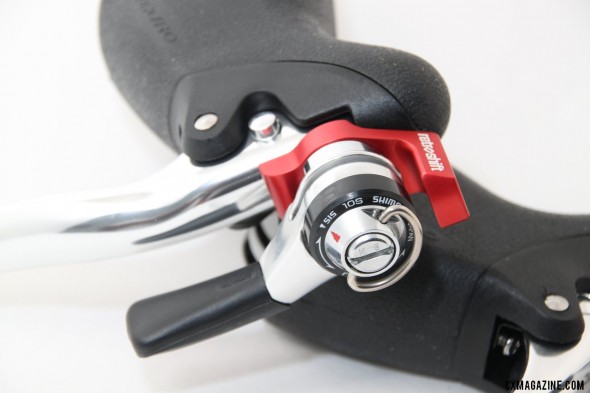
Two nice options on this model: brake lever release button for easy wheel removal and more pad clearance on muddy days, and a friction mode for better shifting with mud or a pit wheel. © Cyclocross Magazine
This capability could be a lifesaver on race day if you grab a wheel from the pits or a buddy that’s not a perfect match with your exact system. Down-tube and Barcon shift levers are so basic that you can easily devise a cable sheath/shim that changes the cable pull per shift. Early Ultegra 6400 7-speed levers had such an accessory—a small plastic piece that partially filled the cable groove, allowing you to also use 6-speed freewheels. There’s no reason you or Retroshift couldn’t build an 11-speed lever with tiny cablepull altering accessories that would allow you to use 10-, 9-, 8- or 7-speed cassettes. After sharing this idea with Retroshift’s Clement, he said he might even consider it. Not a Shimano fan? Retroshift has a Campagnolo system in the works and is looking at SRAM options (although Retroshift will work fine with SRAM cassettes when combined with a Shimano rear derailleur). Clement is also working with shifter manufacturer Microshift to provide another Shimano/SRAM-compatible option.
If you’ve got a component sponsor, mechanic, pit crew and backup bikes, chances are that Retroshift won’t appeal to you. But if you have ever broken a brifter in a race, have had one jam up with mud or sand, are on a tight budget, or don’t want your success to depend on a tiny spring and ratchet when you’re miles (or an international flight) away from home, then Retroshift is worth a serious look. Considering the weight of the shifters and brake levers, Retroshift is lighter than bar-end levers, easy to set up and intuitive to use. Paired with a sealed cable system like Gore’s (discontinued) Ride-On Sealed Low Friction, you might just have the most weather-resistant drivetrain next to a singlespeed.
Retroshift Shifter Specs:
Weight: 388g with two shifters (with Shimano bar end shifters)
MSRP: $189 CX2 levers with shifters, $129 lever without shift levers (with mounts for your own shifters). The CX1 brake lever pair with a right shifter-only retails for $139, and the CXV shifters for V-brakes retails for $189.
Country of Origin: Taiwan and USA
Colors available: Silver or black brake levers, Red or Gray annodized mounts (CX1 comes in 5 colors)
More info: www.retroshift.com (particularly entertaining if you like goats)
Retroshift CX2 Shifter Photo Gallery:













